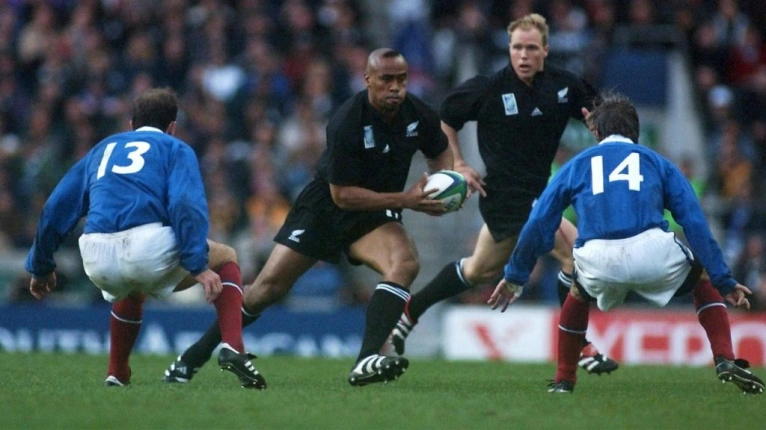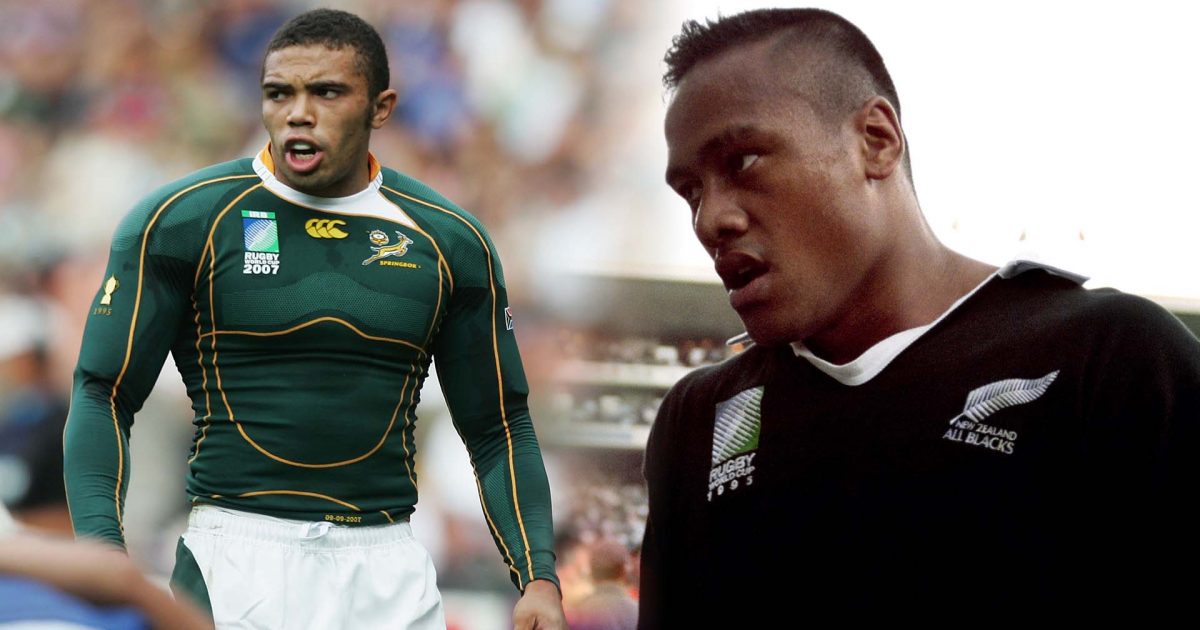Winger - Position Guide

Wingers in a game of rugby union (also known simply as wings) are tricky speedsters who score a great number of tries. Powerful, fast, nimble and athletic, they’re responsible for evading opposition defenders, hunting down kicks and performing try-saving tackles.
Think you have the handling skills, trickery and the raw pace required to play as a winger? Well, read our position guide below and see if the position really is right for you.
What is a winger?
Each rugby team has two wingers (a left winger and a right winger). Both of these players act as the team’s finishers in attacking situations. To do this, they stand close to the touchlines and wait until the ball is spread out to them. From here, they use pace and trickery to work their way past opposition defenders who are trying to cover them.
Although rugby wingers play a vital role when their team is in possession, wingers also play an important role when their team doesn’t have the ball. This is because they’re asked to form the last line of defence.
Other names for a winger
Around the world, some rugby positions are known by different names. However, this isn’t the case with the winger.
That said, while some people refer to the left winger and the right winger, other people do refer to the openside winger and the blindside winger. In these instances, the openside winger plays on the side of the pitch furthest away from the last breakdown (scrum, ruck or maul). By contrast, the blindside winger operates on the other side, meaning they have less space in front of them.
What number is a winger?
As we’ve mentioned, each team has two wingers. The right winger wears the number 14 jersey and the left winger wears the number 11 jersey.
What is the average size of a winger?
Over the years, the height and weight of the average winger has varied massively. For example, former All Black great Jonah Lomu was 1.96m tall (6ft 5in), while Welsh legend Shane Williams was only 1.7m tall (5ft 7in). However, in spite of their vast height differences, both were incredible wingers who oppositions feared.
Today, the average height of a winger is around 1.86m (6ft 1in). However, as we’ve mentioned, height isn’t necessarily a factor that determines whether you can play as a winger.
That said, your height will influence the way you play the position. For example, tall wingers are usually much better under the high ball, while smaller wingers tend to be more elusive runners. Due to this, it’s important that you recognise your strengths and play to them.
Much like with height, the weight of a rugby winger will also determine how they play the game. Generally speaking, wingers take one of two forms: destructive ball runners such as Julian Savea and skilful and quick wingers such as Bryan Habana.
At the larger end of the scale, a winger will usually weigh around 105kg. Meanwhile, smaller and more diminutive wingers will weigh around 90kg. Again, when assessing your weight, it’s important that you play to your strengths. For example, if you only weigh 90kg, you’ll likely have strong pace and acceleration, but you’ll be weaker in the tackle.
What is the winger’s role?
The primary role of the winger is to score tries and finish off a team’s flowing attacking moves. To do this, wingers must ensure they’re in the right position to receive the ball, and then use their pace to weave away from onrushing defenders.
But, a winger cannot simply hog the touchline and wait until the ball arrives in their hands. Most teams also ask their wingers to come in off their wing and provide an extra ball carrying option. This is especially the case for larger wingers who have the ability to carry the ball through contact and create overloads. On top of this, wingers may also be asked to chase high balls or chip kicks.
However, a winger must contribute a lot more to a team than scoring tries and providing attacking support play. Defensively, they must also field high kicks, clear their own territory and perform covering tackles (often as the last line of defence).
What is the winger’s role in scrums?
Scrums are frequent occurrences in a game of rugby union. However, they’re battles between the two forward packs, so the wingers take no part.
However, even though they’re not involved in the pushing and shoving, wingers cannot switch off at scrum time. This is because, if their team emerges with the ball, they need to be ready to attack. After all, the fly half may kick the ball down their wing, pass it along the backs until it reaches the winger or make a mazy run that requires support.
Similarly, if their team loses the scrum, then the winger must be prepared to defend for their lives until the forwards can get back into position.
What is the winger’s role in lineouts?
At the lineout, a team’s two wingers play a limited role.
The winger on the opposite side of the field to where the lineout is taking place will often have a lot of space. Depending on whether their team wins the lineout or not, they can either attack into this space or help defend that side of the field.
The winger on the side of the field where the lineout is taking place has a number of responsibilities. The role they need to fulfil will depend on exactly what happens at the lineout.
If the nearside winger’s team loses the lineout, then they must drop back so that they can deal with a box kick or a long clearing kick. However, if their team wins the lineout, then they will instead be responsible for chasing box kicks or clearing kicks.
Alternatively, depending on their team’s game plan, the nearside winger may also be asked to come in off the wing to take an inside pass from the fly half.
Notable wingers

As they’re the chief try scorers on a team, many wingers are household names. As part of our recent RugbyPass Hall of Fame fan vote, we asked rugby fans from around the world who their favourite left and right wingers of all time were.
Unsurprisingly, they resoundingly told us that the greatest left winger of all time was the legendary Jonah Lomu. He gathered three times as many votes as South African speedster Bryan Habana, who was well ahead of Wales star Shane Williams.
When it came to the right winger, the contest was much more even. That said, Australian legend David Campese was still a clear winner. He was followed in the voting by Doug Howlett, Jeff Wilson, Rory Underwood and John Kirwan.
FAQs
Now, you know all the basics about functioning as a rugby winger. However, if you’re interested in learning even more about the position, then read on. Below, we’ve answered a number of popular reader questions about wingers in rugby, including how to train for the position and the physical attributes required to play there.
Are wingers important in rugby?
In a rugby game, wingers are incredibly important. Inventive and highly skilled players, they’re responsible for spotting gaps in defensive lines, running onto kicks and spreading the play. In low scoring games, a dynamic winger who can break through a small gap can be invaluable.
Similarly, in defence, a quick winger can prevent the opposition getting over the try line. Functioning as the last line of defence, they can be the difference between conceding 5-8 points and keeping the opposition scoreless.
What’s the difference between the left winger and the right winger?
In truth, there isn’t too much difference between the left winger and the right winger, and both players stay close to their own touchline.
Whichever role is best for you will depend on where you feel comfortable. For example, if you prefer to catch the ball when it’s coming from the right, you like to carry the ball in your left hand and you prefer kicking with your left foot, then you’re probably most suited to the left wing.
If the opposite is true, then you’re probably better suited to the right wing. However, both wingers play exactly the same role in the game.
What skills do I need to play as a winger?
As a winger, your most important attribute is your pace. If you can combine your sheer pace with light feet, creativity and evasiveness, you’ll be lethal in possession.
On top of this, you must also possess the ability to bring down opposition players who are already in full flight, and be able to catch high balls.
How fast are rugby wingers?
A winger must be one of the fastest players on the pitch. To give you an idea of just how rapid elite rugby wingers are, England winger Jonny May has been recorded running at 37.71 km/h.
On average, the maximum speed of an elite rugby winger is around 9.15 meters per second, which is seriously rapid. But, it’s important to remember these stats reflect the elite level and there’s no need for you to match these levels in club rugby.
Instead, you should compare your speed against the other players in your team. You should then aim to be the fastest player in your squad… and then league. This applies both over short distances and longer runs.
What training exercises do wingers complete?
To fend off opposition defenders, you must have strong shoulders and a strong core. However, you also need to have high levels of leg strength, as this will improve your acceleration and evasiveness.
To help build your muscles in a way that will improve your wing play, you should focus on completing the following exercises while you’re in the gym:
- Overhead presses
- Wood choppers
- Squats
- Bench-press
- Lunges
- Deadlifts
Although working hard in the gym is incredibly useful, you also need to focus on other aspects of your game. For example, when your gym work is finished, you must also complete a number of kicking and speed drills.
Of course, wingers in club rugby cannot compete with the strength and conditioning standards that are set at the elite level. However, knowing these standards can give you something to aim for.
- An elite winger will be able to:
- Squat 1.6x their bodyweight
- Bench-press 1.3x their bodyweight
- Run 3km in 11 minutes
- Sprint 40m in less than 5 seconds












































































